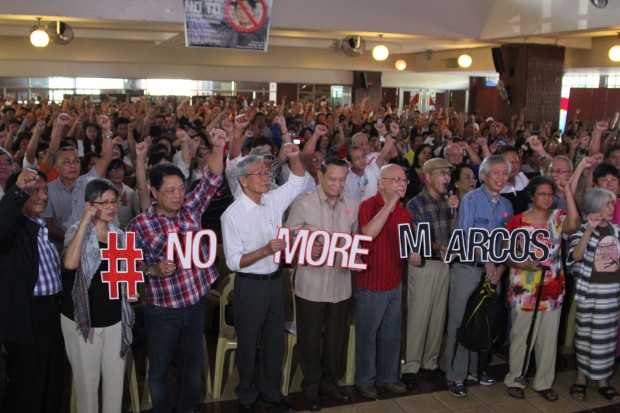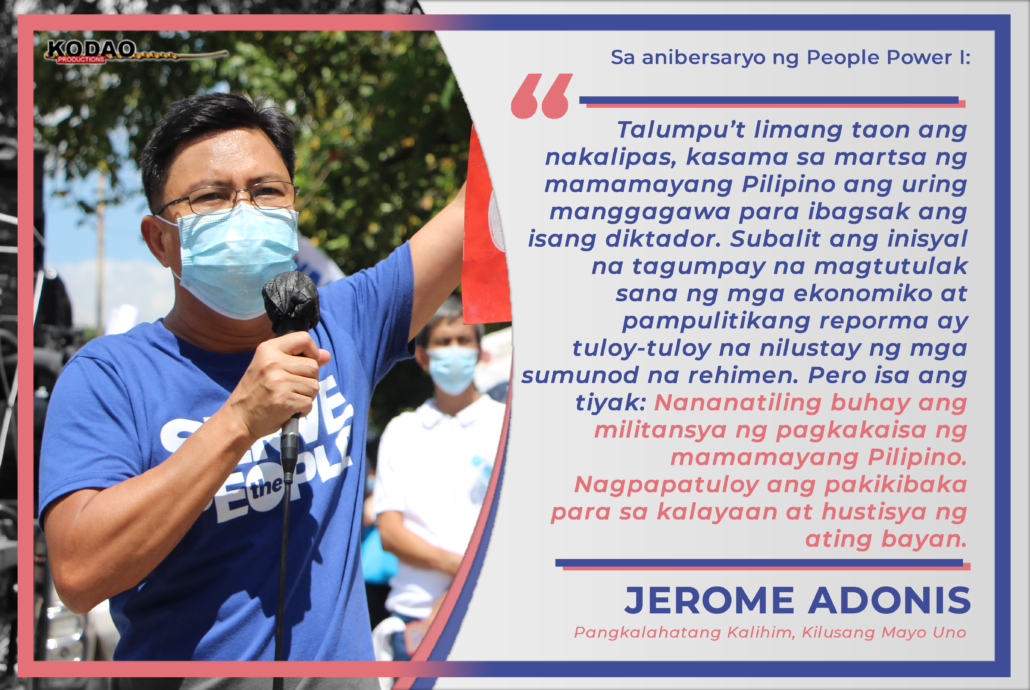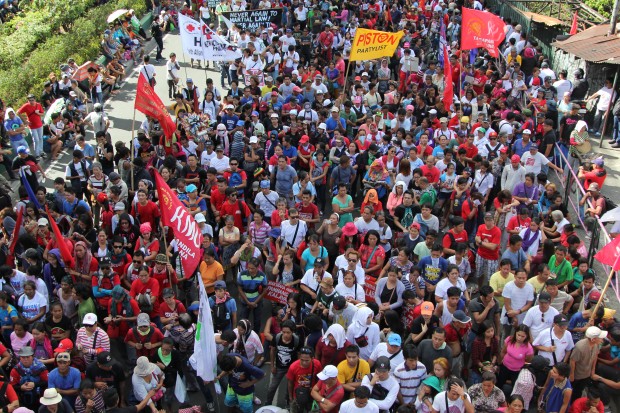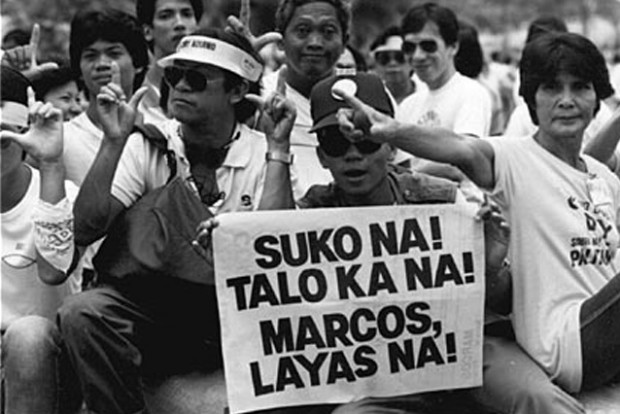
Streetwise
The reputation of the EDSA “People Power” uprising has been getting a beating these past thirty years, especially with an EDSA Dos and even a so-called EDSA Tres following the original phenomenon.
Criticisms range from valid to outlandish. That it merely installed another corrupt, elitist regime and brought back, or even worsened, the ills of the old society premartial law. That it was manipulated by vested interests and shadowy forces. That it was basically mob rule, the anti-thesis to democratic elections that oversee the orderly transition from one regime to another.
Worse, a significant number of young people have been hoodwinked into believing that the US-backed Marcos dictatorship was a a kind of benevolent strongman rule that the present crisis-ridden Philippine society sorely needs to set things aright.
It has been said that Marcos’ imposition of martial law signified the inability of the ruling elite to rule in the old way. Philippine society then was in the grip of another intense socio-economic and political crisis that was but an exacerbation of the long-running crisis of the backward, poverty-stricken, unjust and inequitous social system.
The factional conflicts among the elite could no longer be settled through periodic electoral contests. President Ferdinand Marcos was ending his second term in office and was barred from running again. The infamous Plaza Miranda bombing of the Liberal Party’s leaders was blamed on Marcos. Marcos in turn blamed the communists and his nemesis Senator Benigno Aquino.
Two nascent armed revolutionary movements, one led by the Communist Party of the Philippines and the other by the Moro National Liberation Front, were fast gaining adherents in the countryside. In the urban centers, strikes and demonstrations by workers, students and the urban poor were growing in frequency and militance, mobilizing tens of thousands. They called for and end to the “basic problems” of imperialsm, feudalism and bureaucrat capitalism and the overthrow of the “puppet fascist” Marcos regime.
Marcos’ brutal authoritarian regime lasted fourteen years laying waste the best and brightest of a generation of youth who joined the resistance movement and hundreds of thousands of other human rights victims — from such prominent martyrs as Ninoy Aquino, Edgar Jopson, Dr. Johnny Escandor and Macliing Dulag — to ordinary people who just happened to be in the wrong place at the wrong time.
It brought the economy to ruin by plundering the public coffers in cahoots with its business cronies and favored multinational corporations and by entering into onerous loans and contracts that would take decades for our people to pay off.
It transmogrified the already fascist military and police forces into the dictator’s private army and
into even more abusive and corrupt institutions. It treated the First Family akin to royalty and instituted one of the most entrenched political dynasties this country has had the misfortune of having.
To ensure continued backing from the US government, international financial institutions and the foreign chambers of commerce, it did their bidding in terms of anti-national and anti-people economic policies and programs. The linchpin was Marcos’ maintenance of the US military bases and subordination of Phillipine foreign policy to US dictates.
The EDSA “People Power” uprising signified the end of the Marcos dictatorship because of the magnitude and depth of its crimes against the Filipino people.
Exploitation, oppression and repression breed resistance. This resistance had been building up from the moment martial law was declared — armed and unarmed, in the cities and the countryside, among the people and the disaffected elite, and across the political spectrum from Left to Right as Marcos became increasingly isolated.
Ninoy Aquino’s assasination sparked public outrage that led to mammoth demonstrations. The political crisis pushed Marcos’ erstwhile backer US President Ronald Reagan to pressure Marcos to call for snap elections. Corazon “Cory” Aquino was declared the winner by the people but Marcos had himself inaugurated as president. Cardinal Sin and Cory Aquino called for civil disobedience. The situation threatened to develop into an uncontrollable political confrontation between the US-Marcos dictatorship and the broad anti-dictatorship united front.
The Enrile-RAM aborted coup d’etat triggered the EDSA uprising when people from all walks of life spontaneously poured out into the highway fronting the two military camps to act as a buffer against Marcos loyalist troops and the Enrile/Ramos-led mutinous forces. They were there not for the love of Enrile or Ramos but for their burning desire to oust Marcos and write finis to the dictatorship.
Cory Aquino was physically not at EDSA during the four-day uprising. Corystas conveniently forget this fact when they gleefully point to the inability of Left forces to position themselves prominently at EDSA because of their preceding error of boycotting the snap elections.
But it would be the height of dishonesty and political naivete to say the Left did not play a role in the uprising — before, during and after. As a matter of fact, national democratic activists of workers and students were already at Malacañang’s gates as the Marcos family prepared to evacuate courtesy of the US military.
Moreover, a cursory perusal of the names of the martyrs at the Bantayog ng mga Bayani and the martial law victims who won a landmark class suit against the Marcos estate would show indisputably that the vast majority belong to the Left, under and aboveground.
For the Left, EDSA “People Power” has left a worthwhile legacy of a united and militated Filipino people rising up against the dictatorship and overthrowing it. Unfortunately its powerful democratic impetus was hijacked and coopted by the anti-Marcos reactionaries this time led by the US-backed Corazon Aquino regime.
The promise of meaningful reform was reneged upon. Militant mass mobilizations were suppressed once more. Peace negotiations with revolutionary movements were sabotaged and jettisoned. “People Power” rhetoric was invoked to rally support for the reactionary government and to entrench the reactionary status quo. Is it any wonder that “People Power” has gained such an unsavory reputation among the people, especially the youth, leading to confusion, alienation and even cynicism?
We need to strive harder for our people to learn the hard lessons of the EDSA people’s uprising — the need for fundamental and not just cosmetic change and the indispensable requirement of continuously expanding and consolidating genuine people’s organizations to accomplish this.
In due time, the awesome power of a united people can once more be ranged against the feckless power of the ruling elite in the ultimate showdown. #
Published by Business World
22 February 2016





